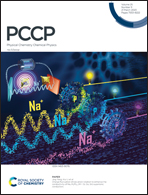Membrane cholesterol regulates the oligomerization and fusogenicity of SARS-CoV fusion peptide: implications in viral entry†
Abstract
N-terminal residues (770–788) of the S2 glycoprotein of severe acute respiratory syndrome coronavirus (SARS-CoV) have been recognized as a potential fusion peptide that can be involved in the entry of the virus into the host cell. Membrane composition plays an important role in lipid–peptide interaction and the oligomeric status of the peptide. SARS-CoV fusion peptide (S2 fusion peptide) is known to undergo cholesterol-dependent oligomerization in the membrane; however, its significance in membrane fusion is still speculative. This study aimed to investigate the oligomerization of SARS-CoV fusion peptide in a membrane containing phosphatidylcholine, phosphatidylethanolamine, and phosphatidylglycerol, with varying concentrations of cholesterol, and to evaluate peptide-induced membrane fusion to correlate the importance of peptide oligomerization with membrane fusion. Peptide-induced modulation of membrane organization and dynamics was explored by steady-state and time-resolved fluorescence spectroscopic measurements using depth-dependent probes. The results clearly demonstrated the induction of S2 fusion peptide oligomerization by membrane cholesterol and the higher efficiency of the oligomer in promoting membrane fusion compared to its monomeric counterpart. Cholesterol-dependent peptide oligomerization and membrane fusion are important aspects of viral infection since the cholesterol level can change with age as well as with the onset of various pathophysiological conditions.



 Please wait while we load your content...
Please wait while we load your content...